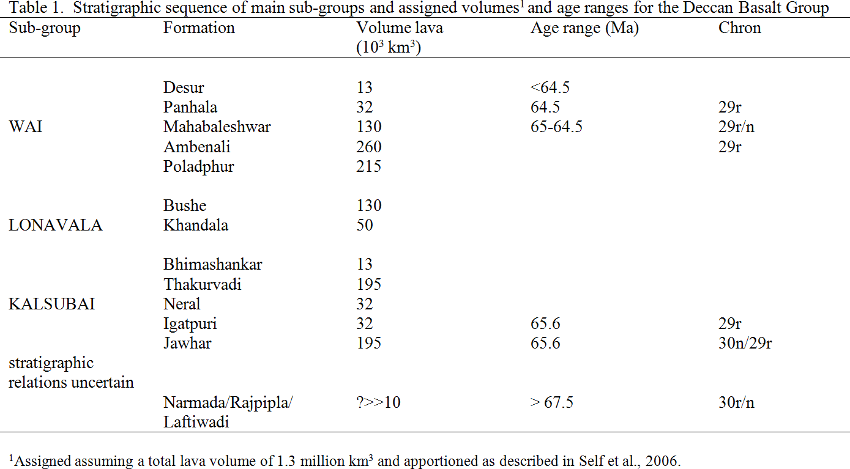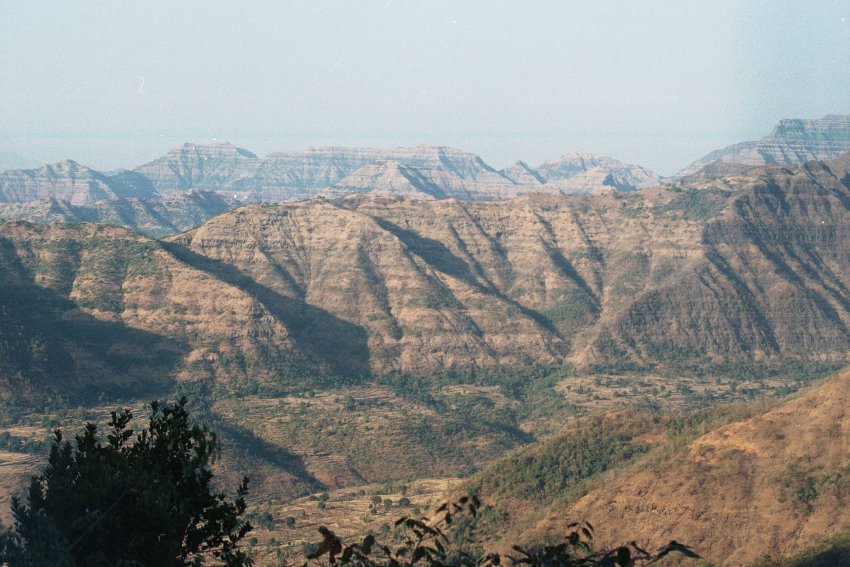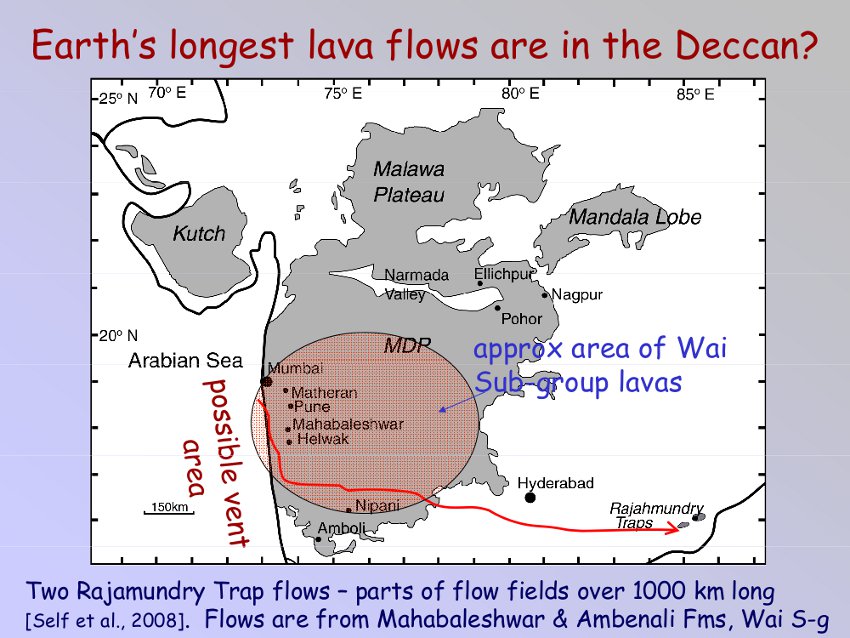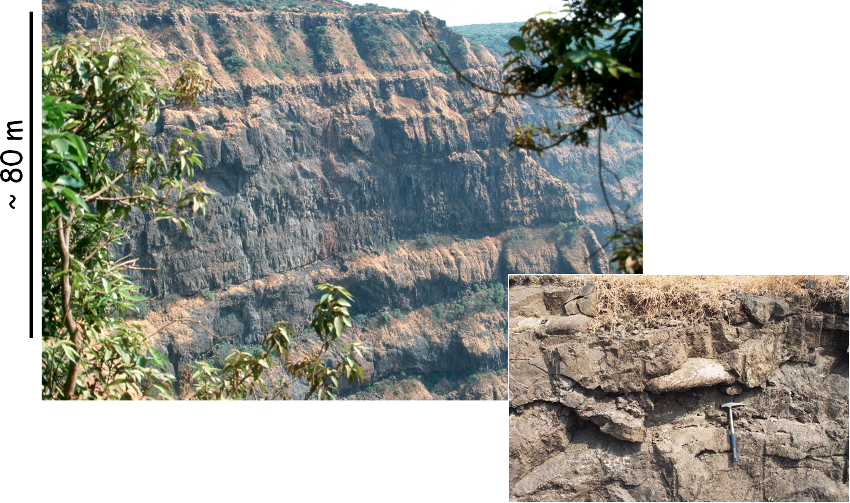May 2012 LIP of the Month
Deccan Volcanic Province (or Deccan Traps), home of Earth’s longest and largest lava flows?
Stephen Self, Visiting Professor, Dept. of Earth and Environmental Science, The Open University, UK (stephen.self@open.ac.uk)
The famous Deccan large igneous province (or Deccan Traps) of India is little explored volcanologically. This is a brief review of some highlights of the Deccan lavas and is by no means intended to be exhaustive. References cited can be used to follow-up on earlier work upon which the facts presented are based.
The Deccan LIP was emplaced between about 67.5 to 64.5 Ma ago, see Table 1 (Self et al. 2006; Chenet et al., 2009). Table 1 presents a stratigraphy that is based on compositional division of the lava pile (each formation is a chemo-type). There seem to have been two or three main pulses of lava production volumetrically – one in the early phases of Deccan volcanism around 67 Ma and at least one in the later phase about 65.5 to 65 Ma (Self et al., 2006; Chenet et al., 2009). Much of the Deccan lava succession appears to fall within reversed paleomagnetic chron 29r, which lasted about 800,000 years (Chenet et al., 2009). One of the later pulses of activity produced the most voluminous formations of the Deccan (Self et al. 2008) and the timing straddles the 29r-29n boundary (Chenet et al., 2008). The products of this later, major pulse are represented by the lava of the lower three formations of the Wai Sub-group and may have been emplaced within about 500,000 years or less.

The volcanic part of the Deccan LIP may have originally totaled > ~ 1.3 million km3 of lava and the portion remaining on peninsular India constitutes about 750,000 km3 (Jay and Widdowson, 2008), covering about 500,000 km2 (Fig. 2). Of this volume, about 500,000 km3 is contained in the Wai Sub-group lavas. These lavas are all pāhoehoe and are dominated by sheet flow lobes (sheet lobes, for short; see Self et al., 1997), which in earlier literature have been called simple flows after Walker (1972) (see also discussion by Bondre et al., 2004; Duraiswami et al., 2008). Smaller-lobe-dominated units of lava do exist but constitute a small proportion (Jay, 2005; Jay et al., in revision). Vents for these lavas have not been convincingly located but dikes of similar composition exist in various swarms with no simple extension/rift-related orientation (Bondre et al., 2006; Ray et al., 2007; Vanderkluysen et al., 2011). Some vents for Wai Sub-group lavas may have been located off the present west coast of India, in the region where rifting later took place.

Figure 1. Deccan lavas of the Wai Sub-group exposed in the Western Ghats of India near Mahabaleshwar. These lavas are part of the sheet-lobe dominated Ambenali (lower part of cliffs) and Mahabaleshwar Formations (upper part). Scarp face seen here is approximately 450 m high.

Figure 2. Map and cartoon showing possible length and distribution of flow fields that reached the area of the Rajahmundry Traps of eastern peninsula India from the main part of Deccan volcanic province. The grey area is the footprint of Deccan lavas, and MDP stands for main Deccan province.
Earlier-emplaced sub-groups and formations of the Deccan are reported to have a higher proportion of “compound” lava fields dominated by smaller pāhoehoe lava lobes, but even within these the pervasive role of inflation in forming the lobes has been recognized (Bondre et al., 2004; Sheth, 2007 and references therein). The Deccan does have genuine 'a'ā lavas (Brown et al., 2011), reported so far from one of the earlier formations (Thakurvadi), but they appear to be a rarity despite the fact that some early literature reported 'a'ā flows to occur more widely. The significance of the more “compound”-flow dominated early formations vs the sheet-lobe-dominated later formations (which are also compound, sense stricto) in terms of vent type, volcanic constructs, and time-averaged eruption rates remains to be explored.
Wai Sub-group lavas have been divided into the Poladpur, Ambenali, and Mahabaleshwar Formations (with a couple of smaller, more limited-area, formations above, Table 1) – these are considered to be the most voluminous formations within the Deccan province (Fig. 1), one formation alone containing more lava than the Columbia River flood basalt province. The sheet-lobe dominated flow fields (the products of one eruption; Self et al., 1998) must be enormous, and in this part of the Deccan lava pile exist what are perhaps the largest and longest lava flows yet documented on Earth.
It has been suggested since the mid-1800s that lava outcrops near the east coast of India – the Rajahmundry Traps – were part of the Deccan province but an occurrence at such a distance from the main province led to uncertainty in this interpretation (explored by Baksi et al., 1994). A few years ago we revisited this issue and showed on the basis of stratigraphy, age, composition, and paleomagnetic character that these are almost certainly Deccan lavas (Self et al., 2008 and references therein). As well as two flows recognized at the surface, one from the Mahabaleshwar Formation and one from the Ambenali Formation, the Rajahmundry lavas include several more in the subsurface proven by drilling for hydrocarbons in the offshore Krishna–Godavari Basin of eastern India (of which the Rajahmundry basin is part). If the vents for these flows were along or off the west coast of India, then the distance flowed was ~ 1000 km, and the arrival of Deccan flows at that distance was not an isolated event. If the vents were in another dyke swarm, then the distances flowed were at least 700 km. The exposed Rajahmundry flows (Fig. 3), which are pāhoehoe sheet lobes, have estuarine-brackish fossil-bearing sediments between them and joint patterns suggestive of water-induced cooling, suggesting that their potential flow distance was limited by entry into the sea. The volumes of lava in these flow-fields can only be guessed at, but is probably in the region of 7000 – 9000 km3. Moreover, Keller et al. (2008) have shown that these massive flows were being emplaced around the time of the K/T (or K/P) mass extinction, an interesting association.

Figure 3. Lava of the Rajahmundry Traps being quarried for road metal (photo courtesy of Matthias Raab). The lavas are 20-30-m-thick sheet lobes (people and trucks provide scale).
During Wai Sub-group volcanism, each eruption must have added an average of 30-40 m of pāhoehoe lava (Fig. 4) over a considerable area, but without complete surface coverage (Jay et al., 2009). It must be stressed that correlations between individual packages of lavas cannot be easily made at the present time, even within a small area (10s x 10s of km), which may reflect the internal complexity of the lava pile (Jay et al., 2009). Thus there, as yet, are no defined flow fields in the Deccan, and the exact size of eruptive units and the number within a defined formation remains elusive. However, it is both exciting and sobering to think that the Deccan province may host lava flow-fields approaching 10,000 km3 in volume and > 1000 km in length. Details of the enormous lava-producing eruptions that formed these fields, such as duration, internal lava-feeding system, and controls on the overall shape of flow-fields need to be worked out. With a predominance of pāhoehoe inflated sheet lobes, large volumes, and the great extent of the flow-fields, eruption durations for these huge events are expected to have been decades to centuries.

Figure 4. Sheet lobes of the Mahabaleshwar Formation well-exposed near Mahabaleshwar; on left can be seen an unusually thick package of lava (~ 80-m-thick), possibly the product of one eruption and composed of 2 sheet lobes; below that package are products of two more eruptions (each a single sheet lobe at this location) and of typical thickness for the Deccan province (25-30 m); inset right shows Mahabaleshwar Formation flows at another location where small pahoehoe lobes dominate in an eruptive package (hammer for scale; mini-lobe above hammer-head is < 50 cm across).
Many advances in volcanological interpretation, pertinent to continental flood basalt provinces everywhere, still remain to be made in the spectacular Deccan Traps.
References:
Baksi, A.K., G.R. Byerly, L.H. Chan and E. Farrar (1994), Intracanyon flows in the Deccan province, India? Case history of the Rajahmundry Traps. Geology 22, 605–608.
Bondre, N.R., R.A. Duraiswami, and G. Dole (2004), Morphology and emplacement of flows from the Deccan Volcanic Province, India. Bull. Volcanol. 66 (1), 29-45.
Bondre, N.R., W.K. Hart and H.C. Sheth (2006), Geology and geochemistry of the Sangamner mafic dike swarm, western Deccan Volcanic Province, India: Implications for regional stratigraphy. J. Geol. 44 (2), 155-170.
Brown R.J., S. Blake, N.R. Bondre, V.M. Phadnis, and S. Self (2011), Aa Lavas in the Deccan Volcanic Province, India, and their significance for the nature of continental flood basalt eruptions, Bull Volcanol. 73, 737-752; doi:10.1007/s00445-011-0450-7
Chenet, A-L., F. Fluteau, V. Courtillot, M. Gerard, and K.V. Subbarao (2008), Determination of rapid Deccan eruptions across the Cretaceous-Tertiary boundary using paleomagnetic secular variation: Results from a 1200-m-thick section in the Mahabaleshwar escarpment, J. Geophys. Res. 113, B04101, doi:10.1029/2006JB004635.
Chenet, A-L., V. Courtillot, F. Fluteau, M. Gerard, X. Quidelleur, S.F.R. Khadri, K.V. Subbarao, and T. Thordarson (2009), Determination of rapid Deccan eruptions across the Cretaceous-Tertiary boundary using paleomagnetic secular variation: 2. Constraints from analysis of eight new sections and synthesis for a 3500-m-thick composite section, J. Geophys. Res. 114, B06103, doi:10.1029/2008JB005644.
Duraiswami, R.A., N.R. Bondre and S. Managave (2008), Morphology of rubbly pahoehoe (simple) flows from the Deccan Volcanic Province: Implications for style of emplacement, J. Volc. Geotherm. Res. 177 822-836.
Jay, A.E. (2005), Volcanic architecture of the Deccan Traps, Western Maharashtra, India: an integrated chemostratigraphic and palaeomagnetic study. Ph.D. Thesis, The Open University, Milton Keynes, 360 pp.
Jay, A.E., C. Mac Niocaill, M. Widdowson, S. Self and W. Turner (2009), New palaeomagnetic data from the Mahabaleshwar Plateau, Deccan Flood Basalt Province, India: implications for the volcano-stratigraphic architecture of continental flood basalt provinces, J. Geol. Soc. London., 166, doi: 1010.1144/0016-76492007-150.
Jay, A.E. and M. Widdowson (2008), Stratigraphy, structure, and volcanology of the south-east Deccan continental flood basalt province: implications for eruptive extent and volumes. J. Geol. Soc., 165(1), 177-188.
Jay, A.E., S. Self, M. Widdowson and S. Blake, manuscript in revision (2012): Physical characteristics and emplacement conditions of lavas in the Deccan province, Western Ghats, India.
Keller G., T. Adatte, S. Gardin, A. Bartolini and S. Bajpai (2008), Main Deccan volcanism phase ends near the K–T boundary: Evidence from the Krishna–Godavari Basin, SE India. Earth Planet. Sci. Lett. 268(3-4), 293-311; doi:10.1016/j.epsl.2008.01.015
Ray R., H.C. Sheth and J. Mallik (2007), Structure and emplacement of the Nandurbar–Dhule mafic dyke swarm, Deccan Traps, and the tectonomagmatic evolution of flood basalts. Bull. Volcanol. 69, 537-551.
Self, S., T. Thordarson and L.P. Keszthelyi (1997), Emplacement of Continental Flood Basalt Lava Flows, in Large igneous provinces; continental, oceanic, and planetary flood volcanism, edited by J.J. Mahoney and M.F. Coffin. American Geophysical Union, Washington, DC, 100, 381-410.
Self, S., L. Keszthelyi and T. Thordarson (1998), The importance of pāhoehoe. Annual Rev. Earth Planet. Sci., 26, 81-110.
Self, S., M. Widdowson, T. Thordarson and A. E. Jay, (2006), Volatile fluxes during flood basalt eruptions and potential effects on the global environment: A Deccan perspective. Earth Planet. Sci. Lett. 248(1-2), 518-532.
Self S., A.E. Jay, M. Widdowson and L.P. Keszthelyi, (2008), Correlation of the Deccan and Rajahmundry Trap lavas: Are these the longest and largest lava flows on Earth? J. Volcanol. Geotherm. Res. 172(1-2), 2-19; doi: 10.1016/j.jvolgeores.2006.11.012.
Sheth, H. C. (2006), The emplacement of pāhoehoe lavas on Kilauea and in the Deccan Traps. J. Earth Syst. Sci., 115(6), 615-629.
Vanderkluysen, L., J.J. Mahoney, P.R Hooper, H.C. Sheth and R. Ray (2011), The feeder system of the Deccan Traps (India): Insights from dike geochemistry. J. Petrol. 52 (2), 315-343.
Walker, G.P.L. (1972), Compound and simple lava flows and flood basalts. Bull. Volcanol. 35, 579-590.
